Basically, you adjust the valve clearances when the cam follower is on the back of the cam. Cams are normally shaped like a section cut down through the centre of an egg. The back of the cam is the end with the larger diameter. In this position, the valve clearance will be ta its maximum. Whatever method of setting the engine to the correct position you use, it will be designed to set the cam follower on the back of the cam.
Note, there are cams that are more rounded than egg shaped, and these are normally adjusted with the engine running. As far as I know, it is mainly General Motors companies that do/did this, so certainly not most UK engines.
My method works because the heel of the cam is 180 degrees of rotation around from the peak, so set the valve fully down means the cam follower is on the peak. The question then is, "how do you know when the cam shaft has turned through 180 degrees". That is easy because the cam shaft turns at half engine speed so if the crankshaft is turned through 360 degrees (one full turn) the cam shaft will have turned through 180 degrees, so the cam follower will now be on the back of the cam.
Although I will always say follow the manufacturer's instructions, the Gardner method seems a bit complicated, but it seems clear enough to me. It is still designed to get the cam follower on the back of the cam.
Don't worry about which stroke, just get the follower on the back of the cam. Both valves will be closed around TDC compression
As both are at a very similar position and the back of the cams have a number of degrees of rotation where they do not lift the follower, it allows you to use piston pairs on an engine with an even number of cylinders and this is what I think is confusing you. Using piston pairs that is not possible on your engine, you would set the non-adjusting piston pair to be around TDC between exhaust and inlet stroke. That puts the adjusting cylinder at BDC



